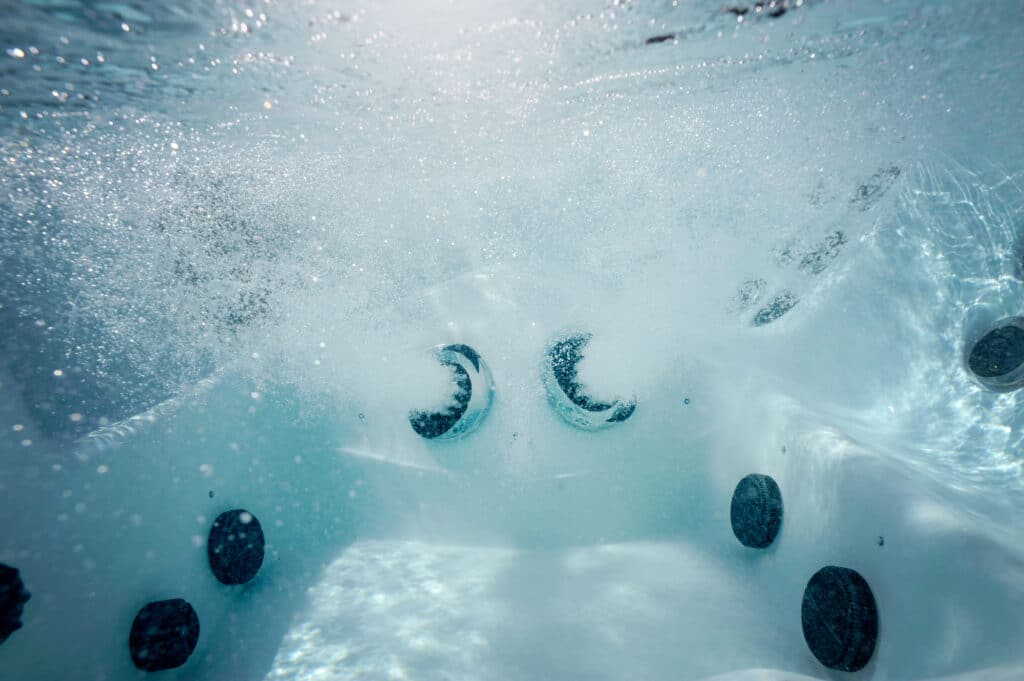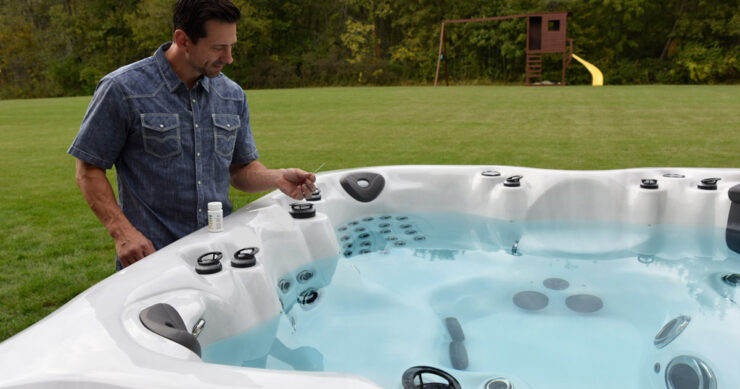You open the hot tub cover, grab a test strip, and swish it through the water. All you want is for everything to come back in range.
But as you pull the strip out and compare the colors, you already know. The pH is too high. Again.
You feel like you’re doing something wrong — even though you’re doing everything right. You test your water. You rinse the filters. You’ve added a chemicals to balance the water. Maybe even the whole bottle.
Still, the levels climb.
If you’re frustrated, we get it. Your hot tub should be a source of relaxation instead of stress. However, there’s good news: You can bring your pH back into balance and keep it there.
Quick fix: What to do if the pH is too high
Are you standing by your spa right now, searching the internet for how to fix your pH? You’re not alone. Here’s what to do.
1. Test alkalinity.
If it’s over 120 ppm, bring it into range before adjusting pH.
2. Add a decreaser.
Follow the product directions. Sprinkle evenly over the surface of the water.
3. Circulate the water.
Turn off the air valves and turn on the hot tub jets. Wait 30 to 60 minutes while the pH decreaser does its job.
4. Retest.
Check the water levels before adding more.
5. Repeat as needed.
Make gradual changes. Overcorrecting can create new issues.
What does pH mean in a hot tub?
Every drop of water has a pH level — including the water that comes from your hose or tap. And depending on your source water, the starting point can vary. Some water is naturally more acidic, while other sources of water are higher in minerals and have a more alkaline base.
In a hot tub, maintaining the right level is essential. It’s a measure of how acidic or basic the water is, rated on a scale from 0 to 14. For spas, the ideal range is between 7.2 and 7.8.
If the pH is below 7.2, the water is too acidic. Go above 7.8, and it becomes too basic or what’s often called “alkaline.”
When pH is in the proper range, everything works better. The water stays clearer. Sanitizers are more effective. And your spa feels more comfortable on your skin. It’s one of the most important numbers to watch when it comes to water care.

Why your hot tub pH might be too high
When it feels like your pH is always climbing, even after adding the right products, it’s natural to wonder what’s going on. The truth is, there might be more than one factor at play and understanding them can make all the difference when it comes to getting your water back in balance.
High alkalinity
If your total alkalinity is above 120 ppm, it can create a buffering effect that resists changes to pH. Even when you add a pH decreaser, the water might not respond the way you expect. Think of alkalinity as a stabilizer: when it’s too high, it locks your pH in place, making it harder to bring down.
Your sanitizer or shock
Some water care products can raise the pH as a side effect. If you’re using sanitizer often or in high doses, it might be contributing to the problem. Check the label on your sanitizer, and consider whether it could be nudging your pH in the wrong direction.
Aeration from jets
Jets are essential for relaxation, but they also introduce air into the water. This aeration naturally causes pH to rise over time. If you’ve been running your spa more often (or for longer sessions), this increased air exposure could be behind your pH drift.
Hard or mineral-rich water
Not all water is the same. The quality and composition of your source water can vary depending on where you live. Factors like local soil, water treatment methods, and plumbing materials can all affect the mineral content and pH level of the water coming from your tap or hose.
If your water contains high levels of calcium, magnesium, or other dissolved minerals, it might already have a higher pH before you even start adjusting it. That means you could be working against elevated levels right from the beginning.
One way to make things easier is to use a hose filter when filling or topping off your hot tub. A filter can help reduce the amount of minerals entering your spa, giving you a better starting point for water care.
What happens if pH stays high?
At first, high pH might not seem like a big deal. The water looks fine. Everything feels more or less normal. But over time, unbalanced water can create a ripple effect that leads to bigger maintenance issue.
When pH is not in range, sanitizers like chlorine don’t work as effectively. That means your water might not be as clean as it appears, even if you’re staying on top of your maintenance routine.
You might also notice the water turning cloudy or your filters clogging more quickly. Scale buildup can start to form on your hot tub shell, around the jets, and even inside the plumbing or heater. These deposits not only look bad but can also affect performance.
For bathers, pH that is not in range can lead to dry, itchy skin and irritated eyes, especially for those with sensitivities.
The longer the levels stay out of range, the more strain it puts on your spa and the harder it becomes to keep things feeling comfortable and clean.

How to lower hot tub pH (and keep it balanced)
Bringing your pH back into range doesn’t have to feel overwhelming. A few steady steps can help restore balance and prevent the levels from climbing again.
1. Start by checking total alkalinity
Before adjusting pH, test your total alkalinity. Ideally, it should fall between 80 and 120 parts per million (ppm).
If it’s too high, use an alkalinity decreaser first. When alkalinity is in range, pH becomes much easier to manage.
2. Add a decreaser
Use a product designed to lower pH, such as sodium bisulfate. Add it in small amounts, based on your spa’s volume and the product instructions.
Run the jets to circulate the water, then wait at least 30 minutes before retesting. If needed, repeat the process gradually until the pH is between 7.2 and 7.8.
3. Keep an eye on the water
After you make adjustments, your water chemistry can still shift over the next few days. Continue testing regularly until you’re confident the levels are holding steady. This helps you avoid overcorrecting or needing to repeat the same steps later.
4. Revisit your water source and spa habits
If you keep running into high pH, look at what might be contributing to the problem.
- Use a hose filter when filling or topping off the spa to reduce minerals that affect water chemistry.
- Consider switching your sanitizer if it consistently raises pH.
- Try shorter jet cycles during balancing, since excess aeration can push pH higher.
How often should I test my hot tub’s pH?
During normal use, test your hot tub water at least two to three times a week using test strips or a liquid test kit. If you’re adjusting chemical levels or noticing cloudiness or odor, test daily until everything stabilizes.
Don’t give up on your water
Balancing pH can feel like a guessing game, especially when you’re doing everything right. But with a little patience, and a few tweaks to your approach, you can get your spa water back in line.
Once the pH is balanced, your hot tub will be easier to maintain and a lot more enjoyable to use.
Because at the end of the day, your hot tub should feel like a retreat — not a chemistry experiment.


